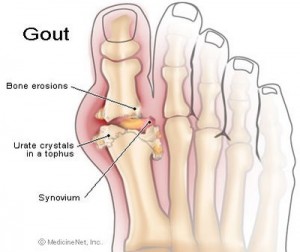Gout is characterized by sudden, severe attacks of pain, redness and tenderness in joints, often the joint at the base of the big toe.
Gout — a complex form of arthritis — can affect anyone. Men are more likely to get gout, but women become increasingly susceptible to gout after menopause.
An acute attack of gout can wake you up in the middle of the night with the sensation that your big toe is on fire. The affected joint is hot, swollen and so tender that even the weight of the sheet on it may seem intolerable.
Fortunately, it is treatable, and there are ways to reduce the risk that gout will recur.
Gout of Big Toe
Common Symptoms
The signs and symptoms of gout are almost always acute, occurring suddenly — often at night — and without warning. They include:
- Intense joint pain. Gout usually affects the large joint of your big toe, but it can occur in your feet, ankles, knees, hands and wrists. The pain is likely to be most severe within the first 12 to 24 hours after it begins.
- Lingering discomfort. After the most severe pain subsides, some joint discomfort may last from a few days to a few weeks. Later attacks are likely to last longer and affect more joints.
- Inflammation and redness. The affected joint or joints become swollen, tender and red.
How is it diagnosed?
Involves inserting a needle into the affected joint and drawing a sample of the fluid that lubricates the joint (called synovial fluid). The fluid is then analyzed under a microscope to determine if uric acid crystals are present and if a blood test (uric acid) is required.
Treatment
- Oral Medications
- Control diets
- Injections
When do you need to see Doctor?
If you experience sudden, intense pain in a joint, call us our 24HR hotline at (65) 64712691 for an appointment. Gout that goes untreated can lead to worsening pain and joint damage.

